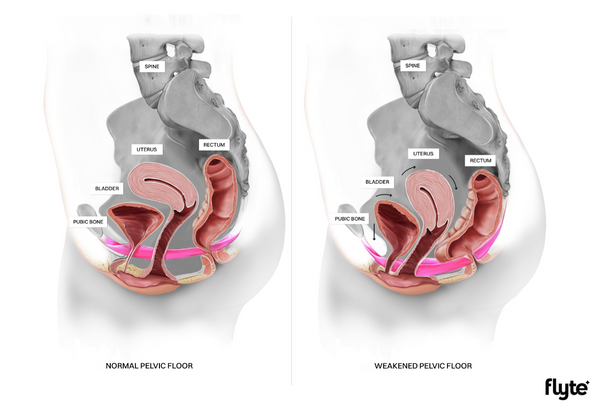Why do I pee during sex?
Accidental peeing during sex is a very common concern for women, with upwards of 27% reporting incontinence during sex – and an even higher percentage experiencing it. Involuntary urine leakage during sex is frequently underreported and has a significant impact on a women’s quality of life. Understanding the causes and finding effective treatments can help women regain confidence and improve their intimate experiences.
Common causes and treatment options
Here are four common causes of urine leakage during sex, along with effective treatment options.
1. Too much pressure on the bladder or urethra
- Cause: Excessive pressure on the bladder or urethra during sexual activity can cause urine leakage. This often happens when the muscles of the pelvic floor cannot control the pressure from above, leading to stress urinary incontinence. When the pressure above the pelvic floor overpowers what the muscles can tolerate, urine leakage occurs.
-
Treatment:
- Alternative positions: When you are concerned about bladder leakage during sex, avoid positions that increase pressure on the bladder like missionary position or an all-fours position. Try alternative positions (e.g., side-lying or on your back with pillows under your lower back to rotate your pelvis forward) to reduce the pressure on the bladder or urethra.
- Pelvic floor exercises: Strengthen and tone the pelvic floor muscles to support the bladder and urethra in just 5 minutes per day with Flyte with results seen in as little as two weeks, making it a top choice for stress urinary incontinence treatment!

2. Weak pelvic floor muscles
- Cause: Weak pelvic floor muscles are a common cause of urine leakage during sex. If the pelvic floor muscles lack strength and tone, sexual activity can exacerbate the problem.
-
Treatment:
- Pelvic floor exercises: To stop incontinence during sex, restoring pelvic floor strength and tone through pelvic floor exercises helps to restore tension around the urethra, preventing urine leakage. Flyte has been shown to amplify the effect of traditional Kegels by 39x – meaning you see results faster! Not sure how to do a pelvic floor exercise? Check out our Kegel how-to guide.
- Pelvic floor coordination: Strengthening and coordinating the pelvic floor muscles are both important for good pelvic floor function. Flyte not only helps with pelvic floor strengthening but also helps guide your coordination and pelvic floor awareness. Check out our blog 3 tips to reduce SUI leaks for additional information and tips for pelvic floor coordination and ways to manage intra-abdominal pressure.
 3. Bladder spasms during orgasm
3. Bladder spasms during orgasm
- Cause: Leaking urine during orgasm is often due to bladder spasms or detrusor overactivity, where spontaneous bladder contractions occur. This condition is commonly associated with an overactive bladder, urinary urgency, and urinary frequency.
-
Treatment:
- Pre-sex routine: Empty your bladder before sex, control your breathing to help manage bladder spasms, and avoid clenching your abs to reduce extra pressure on the bladder to stop incontinence during orgasm.
- Pelvic floor strengthening: Use an incontinence device like Flyte to improve bladder control. Flyte enhances the strength and tone of your pelvic floor muscles, offering an effective solution for female urinary incontinence.
4. Muscle tension from an orgasm
- Cause: During an orgasm, there is a buildup of tension followed by a pleasurable release of tension. This buildup of tension can include excessive abdominal gripping, breath-holding patterns, and bearing down, all of which increase intra-abdominal pressure on the bladder and the pelvic floor muscles. The increased pressure in your abdomen can cause urine leakage during sex.
-
Treatment:
- Awareness and adjustment: Avoid urine leakage during sex with positional changes and be aware of any increase in intra-abdominal pressure. Try a side-lying position to avoid increased pressure on your bladder to allow for better body awareness.
- Pelvic floor strengthening: Use Flyte to restore pelvic floor strength, tone, and bladder control, reducing the likelihood of urine leakage during sex.

Additional Tips and Considerations
Here are some additional lifestyle changes and tips to help manage and avoid urine leakage during sex:
-
Hydration Management: While staying hydrated is essential for overall health, consider moderating fluid intake before engaging in sexual activity. Avoiding food and drinks that are known bladder irritants, such as alcohol, caffeine, carbonation, citrus, spicy foods, and chocolate.
-
Timing: Timing your bathroom visits can help. Try to empty your bladder right before engaging in sexual activity to minimize the risk of incontinence.
-
Communication with Partner: Openly communicating with your partner about your concerns can alleviate some of the stress and anxiety related to urinary incontinence during sex. Understanding and support from your partner can make a significant difference.
- Professional Guidance: If the issue persists despite trying these methods, consult your healthcare provider. A specialist can offer tailored advice and might recommend additional treatments such as an at-home incontinence device life Flyte, pelvic floor physical therapy, medication, or even surgery in severe cases.
- Lifestyle Modifications: Maintaining a healthy lifestyle can positively impact pelvic floor health. Regular exercise, a balanced diet, and avoiding smoking can improve overall muscle tone and reduce the risk of urinary incontinence. For women that are overweight, excess weight puts additional pressure on the pelvic floor muscles. Research finds each 5-unit increase in body mass index was associated with a 20%-70% increase in risk of urinary incontinence, and weight loss of 3-5% can lead to a 47% reduction in symptoms.
Summary
Many people can improve or eliminate urine leakage during sex with pelvic floor exercises and lifestyle changes. By trying the tips above and the Flyte incontinence device to enhance your results, you can achieve better control and enjoy sexual experiences without the worry of leakage. If you do not find success, consult with your healthcare provider about treatment options that are right for you.
Why Choose Flyte?
Flyte offers a noninvasive, clinically proven solution to strengthen and tone your pelvic floor muscles to treat stress urinary incontinence from the comfort of home. Flyte effectively treats stress urinary incontinence in just 5 minutes a day with results comparable to surgery. With Flyte, you can see significant improvements in as little as two weeks, restoring your confidence and quality of life. Flyte’s unique technology amplifies the effectiveness of traditional Kegel exercises by 39x, providing faster and more efficient results than exercise alone. Don’t let incontinence affect your intimate moments – choose Flyte and take control today.











